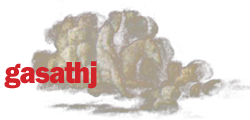The First decade of Computer Graphics - 3 -
Yoshiyuki Abe1 and Akemi Ishijima2
In the 1960s, digital systems became the primary technology of computers and the meaning of the word computing became the processing of program data. Thanks to FORTRAN and Algol, the languages that appeared in the late 1950s, algorithm design became easier, and the possibilities for computer usage was no longer limited to numerical calculations. With the appearance of CRT displays and plotters, computer imaging had entered a new phase. At this time in Germany two pioneers appeared, Georg Nees and Frieder Nake.
3. Georg Nees (b. 1926)
For the world of computer graphics, it was fortunate that a boy who was interested in atomic physics decided to become a mathematician. Georg Nees's drawings produced on a flatbed drawing machine Zuse Graphomat demonstrated the full potential of line drawing via computer programming. He claims himself to be a philosopher and a mathematician, but never an artist. He says his computer graphics were part of the documentation of his aesthetic theory, and they should be considered as models of art. On the other hand, he does not object if someone considers his work as art. With regard to the artistic experience, he says he had never had any difficulties with contemporary music or abstract paintings. He is a rare scientist with the qualities of an artist. That is apparent in his remarks which distinguish the technological innovations from the artistic progress. It is always important for artists using technology to understand that the specification of state-of-the-art equipment would not be enough to ensure the quality of the art work.
Nees describes what he felt while watching the Graphomat's action of drawing his second image (23-corners) in the fall of 1964, "It ran cold along my spine and I thought 'Here is something that will not vanish again. Look artists, one can make abstract art in mass! Why should an artist not let himself be helped by the computer? The artist could use computer graphics as primary designs and work them out by hand.' Meanwhile, for many years now, this has become common practice."
From the path of the mathematician, studying the stability of the power transmission line at Siemens, to the computer drawing seems like an algorithm to bring a pioneer of computer art into life.
Nees started to work at Siemens in 1951 and learned programming in Algol on Siemens 2002 computer in 1959. He was assigned to the new Siemens research center in 1960.
In the winter of 1963-64, a Siemens colleague gave Nees the first seven issues of the new journal Fundamental studies of Cybernetics and Humanities (GrKG)9 and he found Max Bense's papers. In those days Bense had mentioned the idea of pictures as a subject for his information aesthetics, but his primary interest was in texts.
In 1964, the computer center bought the Zuse Graphomat drawing table. This was used for the simulation of cutter paths for NC machines, but it provided Nees with the opportunity to make abstract drawings. His first drawings were produced in the fall of 1964.
Nees had the name of the editor of GrKG, Helmar Frank, a professor at the university of education in Berlin. With his drawings, Nees asked him for supervision of his doctoral dissertation. It was not possible at the university, but Professor Frank introduced him to Bense in Stuttgart and recommended him as a doctoral student on November 20th. The December issue of GrKG included his drawings.
On December 20, 1964, Nees wrote a letter to Bense including about a dozen computer drawings. Bense invited him to a colloquium at his institute. Two surprises were waiting for Nees in Stuttgart. A publication dated February 1965, rot 19, edited by Bense and Elisabeth Walther, included six drawings by Nees with his note, and a statement by Bense inaugurating the generative aesthetics. Second was the exhibition of his drawings at the Studio Gallery at the Technical University of Stuttgart. This is generally acknowledged as the first exhibition of digital computer graphics. A colloquium with known invited artists from the Stuttgart area on February 5th aroused much controversy.
In April 1965, Der Spiegel included the image of 23-corners with its program and reported on the colloquium10.
Later, Nees produced two relief works with NC machines, and a 9 minute animation. "Spuren von Bedeutung (The trace of meaning)" was produced by filming the raster CRT frame by frame with 16mm movie camera in 1970.
Images in GrKG vol.5 Nr 3/4, 1964
Figure 3, 8-corners, 23-corners
Images in the disseration11, 1965-68
Picture 37 (Curls: 210x300mm) and Picture 38 (Schotter: 210x300mm)
Picture 45 (Turbulance centered: 210x300mm) and Picture 51 (One Gestalt: 210x300mm)
Corridor (1969,300x420mm) and Relief_red (wood, 1969, height 1m)
Images: (c)Georg Nees.
Original drawings of Pictures 38/45/51 are owned by Kunsthalle Bremen, Germany.
1 artist, Izu, Japan y.abe at ieee.org
2 composer, London, UK akemi.i at virgin.net
9 Grundlagenstunden aus Kybernetik und Geisteswissenschaft, vol1, Nr1, January 1960.
10 Der Spiegel 18/1965, pp.151-152,
http://www.spiegel.de/spiegel/print/d-46272435.html
11 Georg Nees, Generative Computergraphik, 1969 Siemens, 2006(reprint) Kaleidoskopien, Berlin, Germany 2006
Georg Nees overviewed his own activities in the text of Kuenstliche Kunst:
Wie man sie verstehen kann (Artificial Art: How we can understand it)
in the exhibition catalog of "Georg Nees. Kuenstliche Kunst: Die
Anfaenge (2005)" from Kunsthalle Bremen, Germany.
...to be continued to -4- Frieder Nake.
